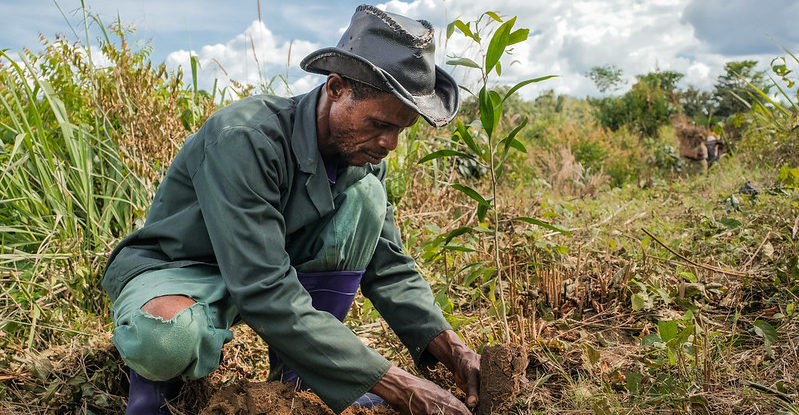
Trees, glorious trees. Let’s plant a million, a billion, a trillion or more.
Tree planting is growing into a global movement amid efforts to restore ecosystem balance and save the planet from the ravages of climate change.
This is what we want, but the simplified concept of “if you need to offset your emissions you plant a tree,” must change.
At the Center for International Forestry Research (CIFOR), World Agroforestry, conservation organizations and entities, naturally we thrive on vegetation, celebrating its proliferation – in particular, trees and forests, the vibrant landscapes, livelihoods and biodiversity that they support.
Some detractors say that tree planting is a waste of time because it draws attention away from cutting fossil emissions, and in addition might result in unintended risks to biodiversity and even to climate change mitigation efforts.
We beg to differ.
Ideas published in two recent papers that appeared in Nature Sustainability journal have stirred up a debate in the popular press over the value of tree-planting in efforts to fight climate change. The key message gleaned is that planting trees is not a simple climate solution.
Yet, this is a fact that we in the forestry community have long known.
One of the research papers says that an intensive tree planting scheme in Chile, subsidized with government funding between 1974 and 2012 was unsuccessful because the country’s primary forests fell victim to profiteering plantation owners. While treed area grew, biodiversity shrank and carbon storage did not increase.
The other paper argues that the standard equation used to measure the potential amount of organic carbon that can be stored through tree planting has been overestimated. It says that although in carbon-depleted soils, planted trees increase the density of organic carbon, in carbon rich soils, carbon density decreases.
These journal articles support what we already knew — that tree growing is not a simple climate solution — offering policymakers a further basis for analysis that can help make tree planting projects more effective in the future.
The massaging of the research outcomes by the press to extrapolate a crisis where there is none, proves that we urgently need to expand the ongoing science-centric dialogue to form the basis of comprehensive national tree-growing programs, within long-term sustainable ecosystem restoration and management strategies.
We have the policy frameworks in place through the New York Declaration on Forests, the Bonn Challenge and the upcoming U.N. Decade on Ecosystem Restoration (2021-2030) not to mention the Aichi Biodiversity Targets and the Sustainable Development Goals.
We must calmly continue to add research findings, including outcomes presented in the Nature Sustainability papers, to the basket of knowledge about tree-planting that we already have, honing and perfecting our capacity to shape programs with the local communities that will manage and benefit directly from the new trees.
Scientific evidence is very clear about the fact that growing the right trees in the right places is one of the most cost-effective actions to enhance carbon sinks, improve the water cycle, protect the soil and support biodiversity. In a 2017 paper led by Bronson Griscom, senior director of Natural Climate Solutions with the Nature Conservancy, researchers highlight the fact that of all possible land-based mitigation solutions, afforestation and reforestation offer the highest potential to remove carbon dioxide.
Beyond doubt, as Griscom and others argue, ecosystem restoration achieved through tree planting is an essential nature-based solution for climate change mitigation. However, landscape restoration programs must be developed holistically with other important strategic measures, including the avoidance of deforestation and preventing forest disturbance losses.
In particular, in a context of accelerating impacts of climate change, adaptation strategies are crucial to enhance ecosystem resilience. The adaptation of our forests, including through tree-planting measures, is key to their maintenance as long-term, effective carbon sinks. These efforts must also include support for biodiversity and other crucial ecosystem services that link to the sustainability of such resources as water and soil.
But tree-growing programs are also fundamental to increasing the sustainable provision of wood, as the basis for a new circular bioeconomy to support job creation in rural areas and decarbonize such industrial sectors as plastic, concrete and steel manufacturers, which now rely entirely on non-renewable materials.
Certainly, tree planting should not be seen as the simple and single solution that some advocate for, but it is a necessary strategic action to mitigate and adapt to climate change, enhance biodiversity, provide jobs and renewable resources for a regenerative economy that prospers in harmony with nature.
We want you to share Forests News content, which is licensed under Creative Commons Attribution-NonCommercial-ShareAlike 4.0 International (CC BY-NC-SA 4.0). This means you are free to redistribute our material for non-commercial purposes. All we ask is that you give Forests News appropriate credit and link to the original Forests News content, indicate if changes were made, and distribute your contributions under the same Creative Commons license. You must notify Forests News if you repost, reprint or reuse our materials by contacting forestsnews@cifor-icraf.org.